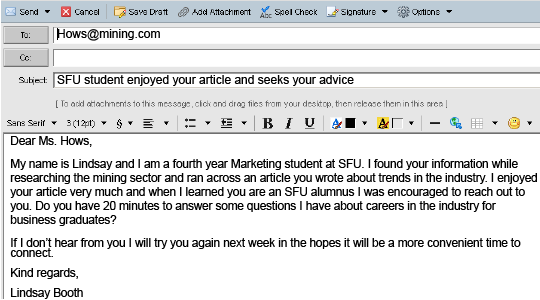
In Step One you learned how to create a list of 40 employers and how to rank them so that your most important and promising employers are in the top 5. Hopefully, most of those employers at the top of your list will have a “Y” for “Yes” in the Friend/Family/Alumni contact column, as it means potential allies for your job search. However, if some of your top tier employers have an “N” for “No” in this column then you’ll need to convert them to a “Y”. Some ways to convert your “N” to a “Y” include attending networking events and information sessions, posting a status update on Facebook saying you’re looking for a contact in a particular company, or joining the same LinkedIn Group as one of your dream employers. One student recently turned his “N” into a job offer by retweeting an article written by one of his dream employers and making a short, insightful comment about it. The employer was so impressed with the student’s Tweet he invited him to coffee which led to a job offer two weeks later.
Now that you have your list of company representatives it’s time to contact them. In Steve Dalton’s book The 2-hour Job Search, he emphasizes that this step is not about asking for a job as this can be off-putting to an employer and result in rejection. The goal is to ask your contacts for a favour: their time.
In order for your contacts to be more likely to grant you this favour, Dalton suggests sending a 5-Point Email that focuses on the employer and not you. The five key points to keep in mind when writing your email are:
-
Fewer than 100 words
-
No mention of jobs anywhere (subject or body)
-
Connection goes first
-
Generalize your interest
-
Maintain control of follow up
Here is an example of an email using Dalton’s guidelines:

This email gets to the point quickly and respectfully and can be read entirely in a single smartphone screen without scrolling. Your email is way more likely to be read and responded to if it is short and to the point like this.
Now you sit back and wait for the responses to roll in! If your contact responds within a day or two – congratulations – you’ve likely found a true ally in your job search. Set up a time for an informational interview with them for a later date (we’ll talk more about informational interviews in Step 3). However, if there is no response to Dalton‘s employer tracking system, the 3B7 Routine should help you determine when to give up and move on to the next employer or when to keep trying. The “B” refers to business days and he suggests after you send your email that you set two reminders in your email service’s calendar for yourself: one to alert you after 3 days and one to alert you after 7 days.
Each reminder has a different action attached to it. If you don’t hear back from your contact within 3 days you move on to the next employer on your list. The 7-day reminder alerts you of when to follow up with your new contact (remember, you said you’d follow up with them the following week). By using this routine, or something similar, you can stay on track and on top of your job search and also identify quickly those people who are genuinely interested in helping you out, or “Boosters” as Dalton calls them (i.e. the person who responds within 24 hours to your email), and those you need to drop because they never respond or those that respond but always put off a time to meet because they are afraid of just saying no. This last category of people are the most frustrating and time-consuming as they get your hopes up but in the end, you realize they never had any intention of helping you. Focus your efforts on the Boosters and your time is well spent.
With any luck, you will now have at least one or two employers able to meet with you for an informational interview (Dalton boasts that most of his students find a job before they hit #10 on their Dream Employer List). I’ll cover what to talk about during the information interview next week in Step 3.





















